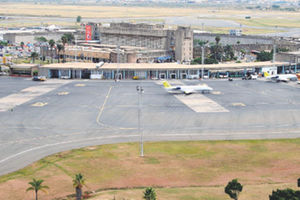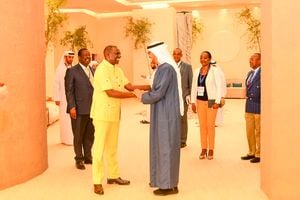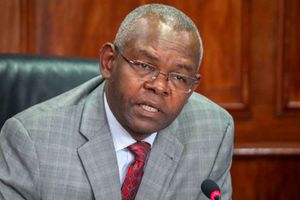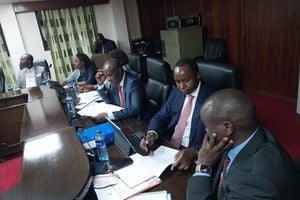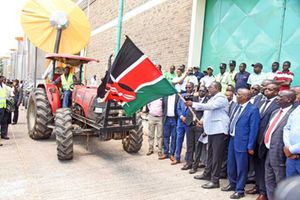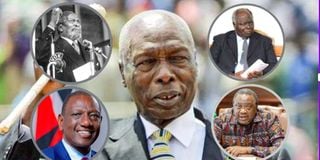
Former presidents Jomo Kenyatta (top left), Daniel Moi (centre) Mwai Kibaki (Top right), Uhuru Kenyatta (Bottom right) and President William Ruto.
The Adani-JKIA deal is deeply troubling and reflects poorly on the government’s ability to manage contracts and public-private partnerships. It appears designed to siphon money from Kenyans and enrich a few individuals.
The fervent opaqueness with which the deal is being undertaken only buttresses American author Avran Noam Chomsky’s observation about privatisation and corruption: Defund a public entity, let it falter, then privatise it. This contract as proposed is only set to benefit Adani regardless of performance and is a clear example of how corrupt contracts are structured in Kenya, continuing a troubling pattern of designing deals to facilitate theft and failure rather than effective service delivery.
Kenya continues to have odious debts and financial obligations, amounting to trillions of shillings. These debts are a burden to the nation’s economic future, having been incurred without public consent and offering little or no benefit to the citizens. What’s particularly troubling is the apparent complicity of creditors, who seem to have been well aware of the questionable circumstances surrounding these loans, yet proceeded nonetheless. These debts too, are a result of contract engineering by fraudulent criminals within and outside the government.
Kenya has had a checkered history of dubious contracts and scandals. These contracts are normally and deliberately engineered to fail and have plagued Kenya since its earliest days as a nation. From the Jomo Kenyatta era to William Ruto’s presidency, corrupt elites have perfected the art of manipulating public projects for personal gain. The names and faces involved may change, but the strategies remain consistent, with every scandal rooted in flawed contracts, inflated budgets, and litigation designed to compensate private interests at the public’s expense.
Political elites
After independence, the Jomo Kenyatta regime faced various scandals involving contracts to benefit political elites. Land grabbing and dubious procurement deals were among the first signs of how contracts could be manipulated for personal gain. Kenyatta’s associates gained control of agriculture, banking, and manufacturing. Those who spoke against government corruption, economic inequality, and land issues like JM Kariuki were silenced.
The Adani-JKIA deal is the latest in a long line of fraudulent contracts since independence designed to loot public resources under the guise of development. Similar to the JKIA expansion deal in 2010, which saw KSh10 billion compensated for “anticipated losses” without delivering results, the Adani deal is engineered for failure. Kenya’s corruption is not random, it’s a systemic issue. Public procurement processes are manipulated, contracts are drawn up with failure in mind, and compensation mechanisms are put in place to ensure that a few elites profit, whether the project succeeds or not. This has become a hallmark of Kenyan governance, where dysfunction is deliberately architected to benefit private capital at the expense of public welfare. The Adani-JKIA deal should serve as a catalyst for reforms.
Goldenberg International
Then entered President Daniel arap Moi, whose tenure was marred by some of the most notorious scandals. Under Moi, Kenya witnessed unbridled theft of public money and with the stand-out scandal being the Goldenberg deal. Arguably Kenya’s largest scandal, Goldenberg involved the government subsidizing fictitious gold and diamond exports through the company Goldenberg International. The scheme led to the loss of over US$1.5 billion, equivalent to 10 per cent of the GDP at the time. The scandal centred on two companies, Goldenberg International and Exchange Bank Limited. They were owned by businessman Kamlesh Pattni and the then-Intelligence chief James Kanyotu. The two were licensed to export gold and diamonds from Kenya but instead, they just collected inflated subsidies.
Turkwell Power project
The other humongous scandal in the Moi era was The Turkwell Hydroelectric Power Station project, initiated in 1986. The project is a classic example of contract engineering and problematic procurement practices. This involved the construction of a hydroelectric dam on the Turkwell River. The project was overpriced, and questions arose over the engineering contract being awarded without proper vetting. The main contractor, a French company, Spie Batignolles, lacked experience in such projects. The project cost ballooned to $450 million, double its initial estimate, and produced much less electricity than projected.
Fertiliser mess
The KenRen Fertiliser Scandal happened in the 1970s. It involved the establishment of a fertiliser plant through a joint venture with the government and a foreign firm. The project, meant to promote agriculture, collapsed, leaving Kenya with substantial debts. Moi inherited this from Kenyatta’s era, but the mismanagement of the contract continued, eventually costing the government millions.
Anglo-Leasing deals
Anglo-Leasing Finance was paid about $33 million (£21 million) to supply the government with a system to print new high-technology passports while other fictitious companies involved in the scam were given money to supply naval ships and forensic laboratories. And despite promising to fight corruption when he took office, President Mwai Kibaki’s administration too joined the bandwagon and was marred by several high-profile scandals.
Triton Oil
The infamous Triton scandal involved Triton Petroleum, a company linked to businessman Yagnesh Devani, which illegally released oil from the Kenya Pipeline Company (KPC), using fraudulent contracts without the knowledge of financiers. The oil was sold off, leaving banks with losses amounting to over $100 million.
Maize scam
Between 2008 and 2009, a maize scandal hit the Kibaki administration. A maize shortage prompted the government to allow imports to stabilise prices.
However, maize intended for famine relief was hoarded by well-connected individuals who inflated prices, sold the maize back to the government, and profited from it.
Education
In the same period, funds meant for the Free Primary Education (FPE) program were embezzled by education officials. Millions of shillings were stolen, leading to an international outcry as donor countries like the UK and the World Bank demanded accountability, resulting in the suspension of aid to the program.
Eurobond
In 2014, Kenya raised $2.75 billion through a Eurobond (international bond) issuance. However, it is alleged that a large portion of the money could not be accounted for. The opposition claimed that $1.2 billion went missing, though the government denied the allegations.
NYS cash
The National Youth Service was at the centre of two major scandals. In 2015, around KSh791 million ($7.9 million) was allegedly stolen through fictitious contracts, implicating senior officials and businesspeople. The 2018 NYS scandal was even bigger, with KSh9 billion ($90 million) allegedly siphoned off through fraudulent procurement deals.
The scandals revealed deep-seated corruption within Kenya’s youth empowerment initiatives. This scandal involved the theft of KSh5 billion ($50 million) from the Ministry of Health, allegedly through irregular procurement deals and manipulation of accounting systems. Funds meant for hospitals, medicines, and health infrastructure were lost, leading to public outrage.
Irrigation scheme
The other scandal that defined Uhuru Kenyatta’s presidency was the Galana-Kulalu Irrigation Project. This ambitious project aimed to address food insecurity by irrigating one million acres of arid land. The project cost KSh7.3 billion ($70 million) but failed to produce the expected results. Investigations revealed gross mismanagement, inflated costs, and contract irregularities.
Arror & Kimwarer
And who can forget the infamous Arror and Kimwarer dams’ scandal? KSh63 billion ($630 million) was allegedly paid in advance for two dam projects that were never built. The Italian company contracted for the project received significant payments, but there was no progress on the ground.
Global Citizen, Delivery Systems, and Capability Maturity Thought Leader. [email protected]
